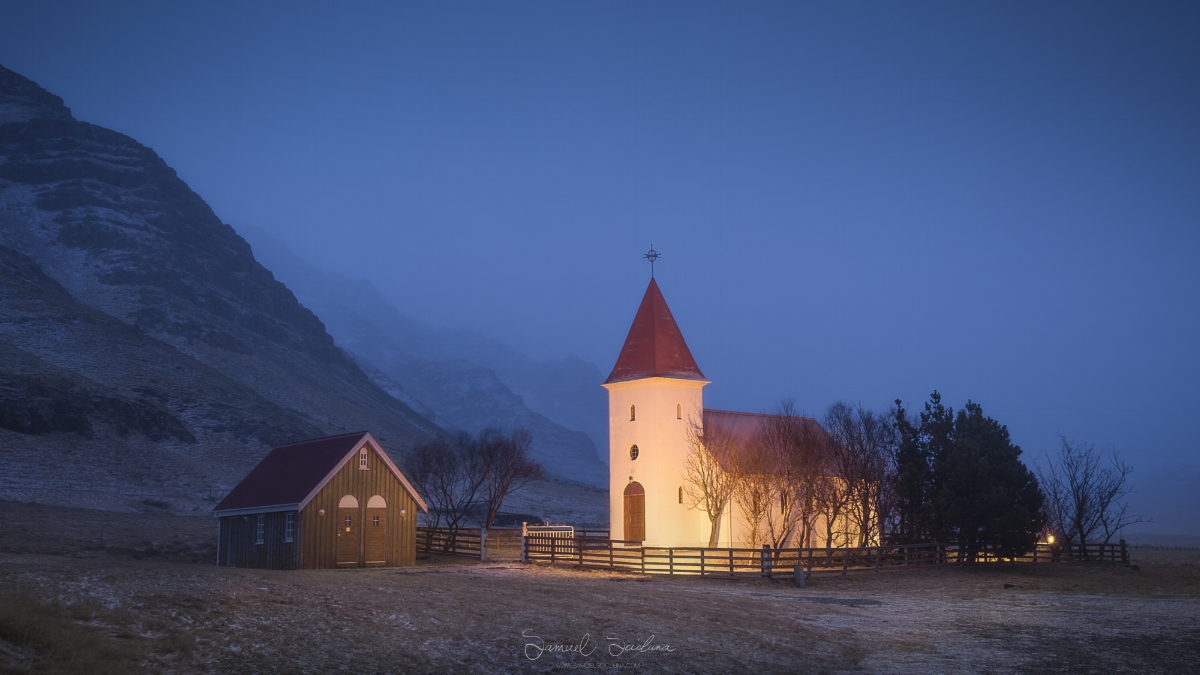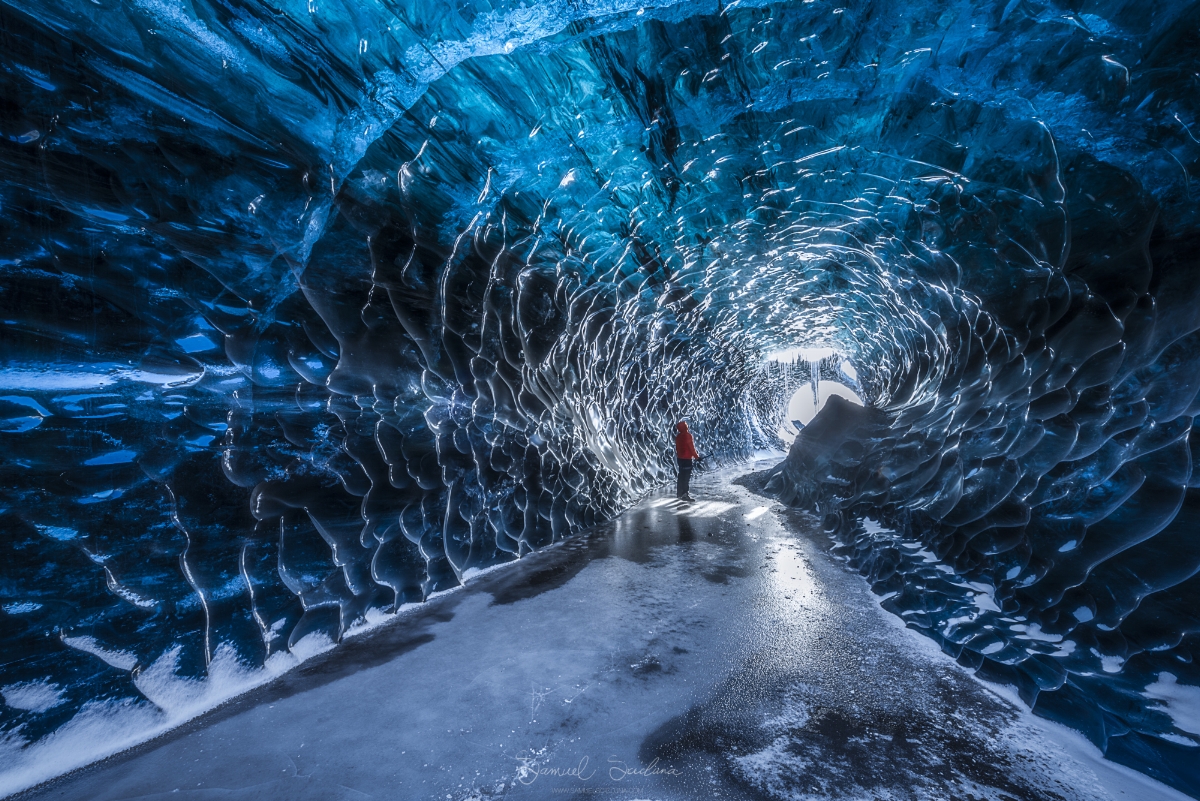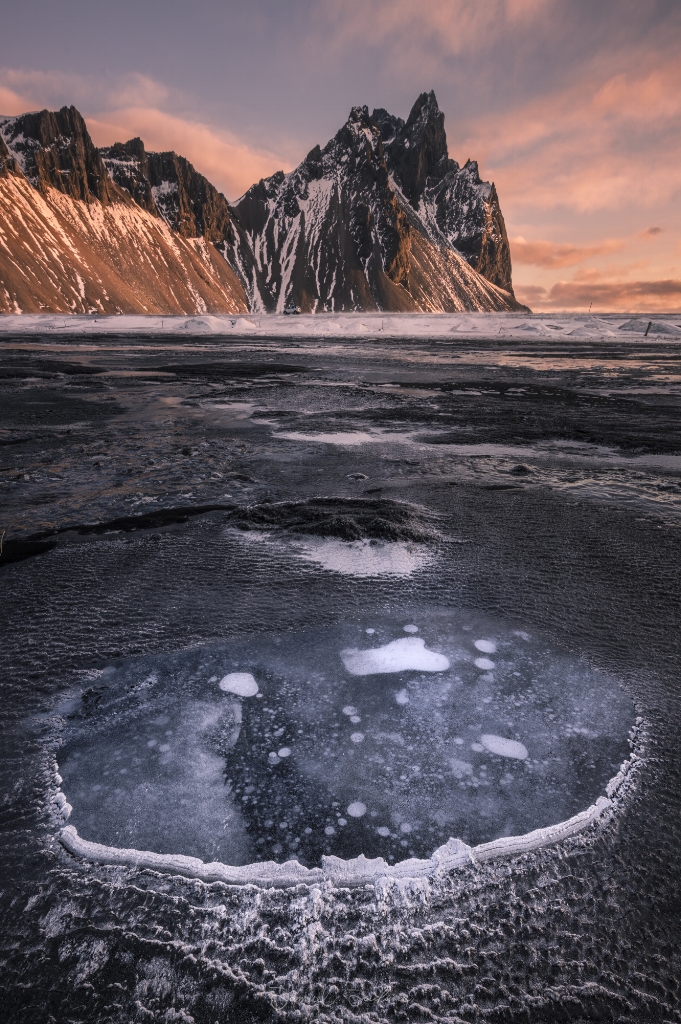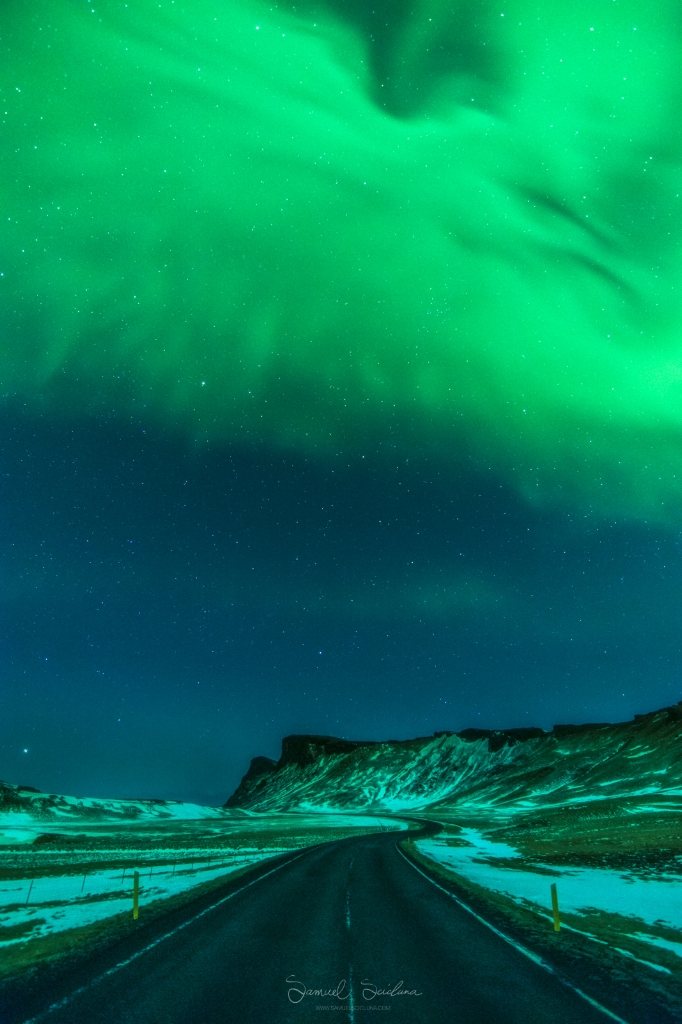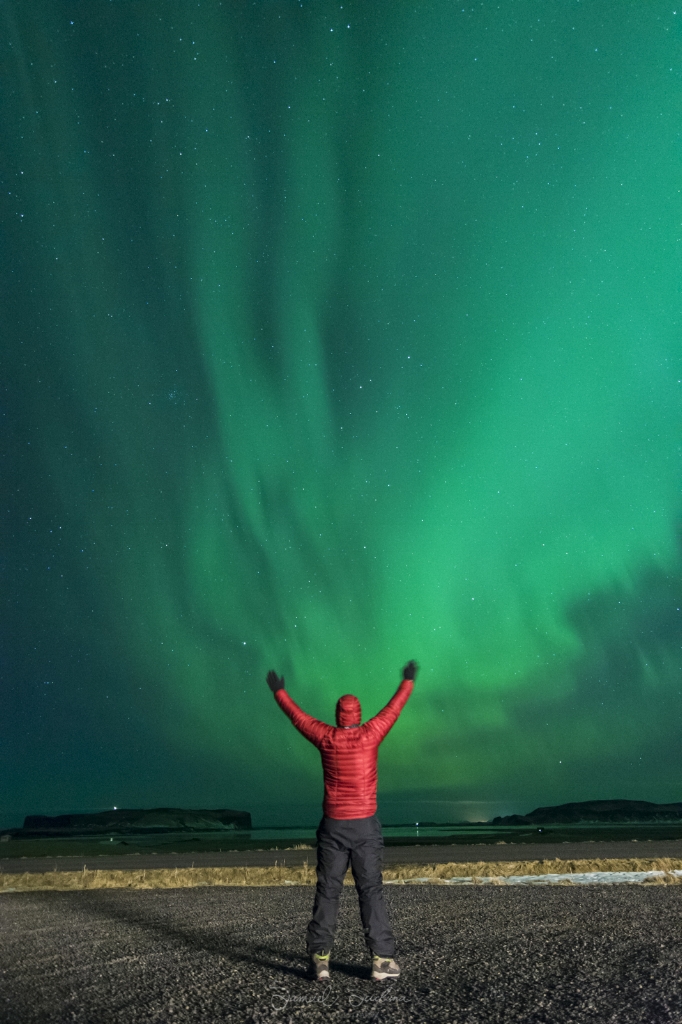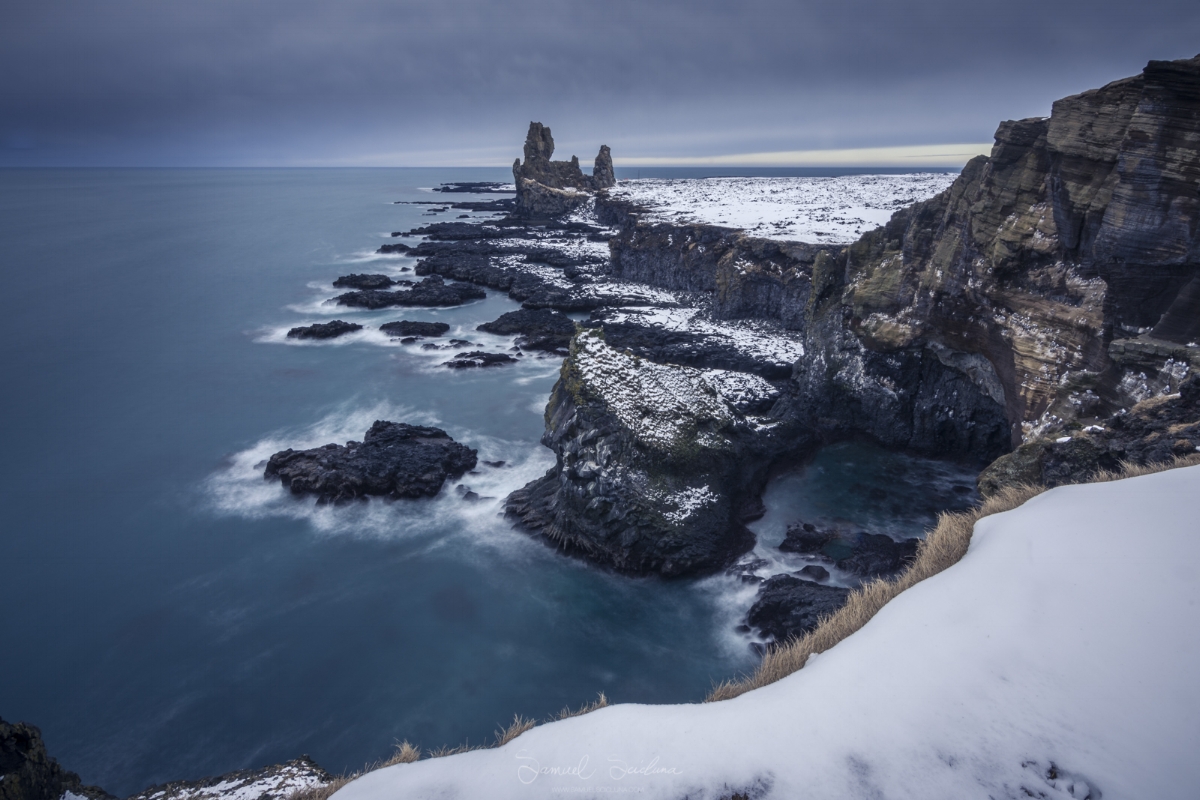In March 2018 I headed back to Iceland for the third time, and Fredrick Muscat from www.fredrickmuscat.com joined me. We had 2 main objectives for this trip, the first was to photograph an Icecave, the second to photograph the Northern Lights. I had never been to Iceland in winter before, and this was Fred’s first time in Iceland, so it was definitely going to be an awesome trip! This blog covers our fantastic journey across most of Iceland.
We were significantly delayed for our connecting flight, meaning instead of landing in Iceland at 18:30, we landed at about 22:45. We picked up our rental car, and our plan was to drive for 2 hours to get to our accommodation. We were absolutely knackered, having been on our feet and travelling all day long. Whilst driving near Reykjavik, I spotted some faint auroras ahead of us, Fred wasn’t convinced, but I reassured him that it was the Northern Lights! We stopped at the next rest stop, grabbed our cameras and managed to get a few shots, and low and behold, it was the Aurora! This suddenly filled us with energy, we raced to get to our accommodation to check in and change our clothes as, having just come from Malta, we weren’t dressed well enough to cope with the freezing cold!
We drove to a little church near where we were staying, and grabbed a few shots of the weak Auroral activity, it was nothing worth writing home about, but it was a great start to our trip!
The next day we headed to scout both Seljalandsfoss and Skogafoss waterfalls during the day, with the plan to head to Seljalandsfoss for sunset and Skogafoss for sunrise the following morning.
Seljalandsfoss waterfall after sunset. Icicles and frost adorn the great waterfall!
That night, there was some unexpected Auroral activity, we headed to Seljalandsfoss to get some shots. It was freezing cold and very windy, I had both cameras shooting timelapse sequences, and I turned to get my drink from the car. As soon as I closed the car door, I heard a loud thump and then the unmistakable sound of metal cracking. I looked back to where my camera was, but found it lying on the floor, with the lens about a meter away from it. This was my main camera, my Nikon D810, and the camera with which I planned to capture all my still images, I had brought my other 2 cameras solely to shoot timelapse sequences as they are older and the image quality is not as good as my D810, but that clearly all changed now that my D810 was in bits.
Needless to say, I was gutted, my main workhorse was down and it was just the first full day of the trip… I wanted to cry and just go back home there and then.
Ouch! I’m glad I had insurance…
The following morning we headed to Skogafoss for sunrise, I wasn’t in the mood to shoot, I was still really upset about my camera and just couldn’t be bothered. Luckily, Fred gave me a bit of a pep talk, told me to grow a pair, get over it and make the most of the rest of the trip. He was absolutely right, we were in Iceland after all, and I still had 2 other cameras which I could use to capture images. That was all the convincing I needed. We headed out and I captured this shot of Skogafoss waterfall.
Skogafoss waterfall before sunrise with some awesome frozen bubbles in the foreground.
Not being able to use my trusty Nikon D810 and the super sharp 16-35 lens, meant that for the rest of the trip, I had to work a lot harder for my images. To make things worse, my cheap wide angle lens was stuck wide open at F2.8, probably due to the extreme cold, which meant most of my photos were soft and out of focus, this led to me having to focus stack all of my images when using that lens for the rest of the trip.
The next day we drove further East and headed for Jökulsárlón glacier lagoon, the weather was absolutely terrible, so we skipped sunset and instead shot this gorgeous little church during he blue hour, on our way to the guesthouse. The blizzard that had been forecasted was hitting Iceland, and was bringing snow with it! Luckily, the low visibility worked out in our favor for this image, and gave a very surreal feeling to this scene, as most of the mountains in the background were no longer visible.
A little church on the side of the road near Kálfafellsstaður.
We didn’t stay out late that night, as the next day was going to be ‘The big day’, the day we had booked months in advance for our Ice Cave tour!
We couldn’t help but feel ecstatic seeing pristine fresh snow falling before us. This was the first time either of us had seen fresh snow falling, so a couple of Facetime calls to our loved ones were in order to share this special moment!
Snowy Selfie!
Whilst standing in the fresh snow, I contacted our guide for the Ice Cave tour just to confirm everything was fine and the tour was still going ahead. He said as long as there wasn’t too much snowfall overnight, which would make getting to the ice caves impossible, we would definitely be going! We packed our camera bags with only the essentials, to try make them as light as possible and got rid of anything we didn’t need. We then hit the sack to get a full night’s sleep.
A bit about Icecaves…
Icecaves are a completely natural phenomenon, they are formed by glacial melt water passing under the glacier. Icecaves are ever-changing due to their nature and this makes them unique. You could visit the same ice cave a few weeks apart and it will be completely unrecognizable, this is because the caves are constantly melting, some parts collapse and others are formed.
Hiking across the glacier to reach the Icecaves.
You cannot access an Icecave on your own, they are almost impossible to find and even if you did find one, you wouldn’t know if it is safe to enter or not, you need to go with a guide. I will repeat, You need to go with a Guide! I would definitely recommend Stephan from Háfjall. He was incredibly knowledgeable about everything related to glaciers and ice caves and only offers private tours (No large groups). Your guide will provide you with all the necessary safety equipment, which includes a helmet, crampons, a harness and an Ice pick. Your guide will take you to whichever caves are considered ‘safe’ at that point in time, as not all Ice caves can be accessed at any one time throughout the season.
Icecaves can only be accessed between between roughly mid November and mid March, but even this isn’t guaranteed, as it depends on the weather and climate, in year which is colder than usual, the season may be a bit longer. Icecaves can’t be accessed at any other time of year, the temperature is just too warm and the Icecaves are extremely unstable, rapidly melting, with large chunks of the caves collapsing frequently.
Icecaves can also get pretty messy inside, as they are full of fine grained clay and sand which has been produced by the glacier crushing the bedrock beneath it as it moves, for this reason, you need to wear proper outdoor clothing, such as a hard shell jacket and trousers, and also ensure that any equipment you have is weather sealed, as the fine sand and clay can get stuck in all the delicate nooks and crannies causing some major issues!
Before the Icecave season opens, the glacier guides explore the glacier to look for new and safe ice caves for the coming season, they also make these caves accessible by building bridges like the one above.
The Ice cave we visited was called ‘Treasure Island’, it was a complex of two caves on the tongue of the Breiðamerkurjökull glacier. The 2 caves were just a couple of minutes walk apart. To get to these caves, we had a 45 minute drive in a modified Super Jeep, on what can only be described as driving on the surface of the moon, a normal car, even a 4 wheel drive, would never get to this location, its just too rough.
The super jeeps which go to these Ice caves have tires which can be as big as 46 inches high to give them enough ground clearance! They also have automatically inflating / deflating tires, for when they need to drive on snow and ice! Once we got to the make shift parking lot, we got geared up and then traversed the 4km across the glacier to reach the entrance to the caves.
A selfie inside ‘Treasure Island’ Ice cave.
Our guide was kind enough to pose in the window of the ‘Treasure Island’ Ice cave. Having a human figure in the shot really shows just how big these Ice caves!
Another Selfie, this time in the other ‘Treasure Island’ cave. Above me is moulin, a huge shaft, probably 30 meters high, from the surface of the glacier, right down to the bed rock. Moulins are extremely dangerous when walking on glaciers, as a fall there would lead to certain death.
After some convincing, our guide decided to give us a truly unique photo opportunity, he agreed to abseil down into the moulin from the surface of the glacier. This is one of my favorite shots of the whole trip as it is truly unique!
Our Glacier guide preparing to abseil / rappel down the moulin. I composed my shot to include detail in the ice on the left, with the guide on the right.
We walked back to the car, absolutely buzzing with what we had just experienced, and knowing we had captured some amazing photos! We knew that we were still in time for sunset at our next location, Stokksness, so we hit the road and drove the 90km to get there fairly quickly!
By the time we got to Stokksness, the light was already super, so I set about trying to find a compelling composition. I shot this panorama, which includes some interesting swirls in the frozen sand and snow trapped in the swirls. There is also a photographer in the frame to show just how huge this place is!
Gorgeous light before Sunset at Stokksness.
The next morning we again had some amazing light, and this time we had some clouds which were on fire! This shot is also a panorama, to ensure I could include all the scene as my wide angle lens was just not wide enough to fit everything in!
A gorgeous sunrise at Stokksness, sat on a frozen pond!
Frozen air bubbles in a little pond with some epic mountains in the background!
After spending two nights at Stokksness, we started to backtrack along the south coast of Iceland. We spent a night near Jökulsárlón glacier lagoon, we again got really lucky with the weather and pulled an all-nighter chasing the Northern Lights in loads of locations near Jökulsárlón.
The Northern Lights mirror the shape of the banks of Jökulsárlón glacier lagoon.
An explosion of Auroral activity above the famous suspension bridge at Jökulsárlón glacier lagoon.
The next day we continued back tracking and got to the town of Vík í Mýrdal. We shot sunset at the Dyrhólaey arch before having a good dinner at our guesthouse. At 21:15, we headed out for what was to be another all-nighter shooting the Northern Lights. We shot at about 10 different locations all around Vík í Mýrdal, the below photos were all shot on that night.
The Northern Lights dancing over the Arnardrangur Sea Stack.
The Northern Lights above the coast in the South of Iceland.
A huge burst of activity above the road to Vík í Mýrdal.
The Aurora over Hatta mountain, near Vík í Mýrdal.
A Panorama of 10 images showing some really strong activity near Vík í Mýrdal.
After running out of compositions, I decided to just take a good old selfie!
The next day we revisited Seljalandsfoss and Skogafoss waterfalls and spent the night near Skogafoss. We knew there was a slight chance of some very low activity that night, so we headed to Skogafoss waterfall to wait it out and try to capture it. We were there for about 2 hours, and loads of photographers came and left before mother nature decided to comply, and we were given this little burst of activity as a treat!
Skogafoss by night with the Northern lights dancing in the sky above.
The next day we headed to the golden circle to see some of the main touristy spots. We spent the night near Laugarvatn which meant we could shoot sunset at Bruarfoss and sunrise at Strokkur the following morning. Strokkur is a natural geysir which erupts every few minutes.
The warm colors of sunset reflect off the snow along the banks of Bruarfoss, the famous blue waterfall!
The first light after sunrise hits the epic Strokkur geysir, as it shoots steam upto 20 meters high!
We then had a long drive to get to the Snæfellsnes peninsula. The roads were pretty slick due to some fresh snow, but we knew this would help make our photos more interesting. We headed over to Kirkjufell mountain for the classic shot, but although we were there more than 2 hours before sunset, we found it was already pretty busy!
Kirkjufell is a very popular location at sunset, you can see that if you don’t get there early, you won’t find a spot!
Put off by all the people, and having already previously captured this composition, I headed off to the little lake nearby to try find an interesting foreground to create something more unique.
I found a cone shaped patch on the frozen lake and used this as a leading line, but also as it mirrors the shape of the mountain. The high clouds caught the light before sunset and helped make a great shot!
That night was completely cloudy, so there was no chance of seeing the Northern Lights, but there was some color at sunrise the following morning, and I captured the below selfie.
A selfie from the frozen lake near Kirkjufell at sunrise.
Sunset the next day had no clouds, but there was some great light, I managed to find a patch of cracked ice to use in my foreground. I was standing on the frozen lake to take this shot, and needless to say, got slightly wet when the ice cracked, luckily it was only about 4 inches deep!
Great light before sunset at Kirkjufell!
The clear sky at sunset and small possibility of seeing the Northern Lights in this location led to us spending about 3 hours sat on this frozen lake in the middle of the night, waiting for something to happen. The activity was not crazy, but just enough to get the below shot.
The Northern Lights above Kirkjufell reflecting in a frozen lake.
The next morning we headed out of the Snæfellsnes peninsula, we made a couple of stops along the way to see some iconic locations such as Londrangar, Arnarstapi and Búðakirkja. A huge snow storm hit and we got caught in the middle of it whilst heading back to Reykjavik.
The epic Lóndrangar cliffs on the Snæfellsnes peninsula wearing their winter coat!
The storm intensified as we got towards Búðakirkja, but we stopped as we wanted to get a simple shot of the classic black church with the mountains behind it.
Búðakirkja in a blizzard!
Once we got our shots of Búðakirkja, we continued driving to Reykjavik, where we spent our last night. We packed our bags and reviewed our shots, knowing we had managed to capture some great images!
If you are not familiar with Fred’s work, check out his website www.fredrickmuscat.com as he has some absolutely amazing images!
As always happens with Iceland, sitting at the airport waiting to fly home, I couldn’t help but think, I will be back someday…




